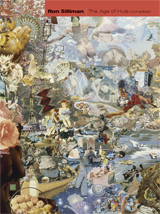Sun 1 Jul 2007
Here’s a short review I wrote some time ago on commission of Ron Silliman’s The Age of Huts (compleat)Â which I’ve just rediscovered on my hard drive and thought to share.
Ron Silliman
The Age of Huts (compleat)
University of California Press
New California Poetry 21
This beautifully designed new volume collects for the first time the four components of The Age of Huts, including one of the prose poems he is best known for, Ketjak (previously published as a standalone volume in 1978) and the entirety of the original 1986 Roof edition of The Age of Huts, which contained “Sunset Debris,†“The Chinese Notebook,†and “2197â€â€”both books now have firm places in the Language Poetry canon. Silliman, coiner of the term “the New Sentenceâ€â€”a theory of poetry that promotes parataxis as the distinctive postmodern form—and author of a critical volume with that title, has taken on new guises since the publication of the publication of these early works, especially as the author of the volumes-long “life work†The Alphabet and as inveterate blogger and taunter of mainstream poets he has designated the “School of Quietude.†Regardless of the value one grants his recent critical writings on poetry, The Age of Huts (compleat) shows a dynamic artist who is questioning of nearly all of the assumptions of English-language poetry to that time, picking away at questions of form and content as it has been traditionally understood since the Romantics, but also figuring himself on the cusp of more recent poetic theory centered around the Beats, Projectivists, and other “New American†poets of the fifties and sixties (not to mention conceptual art and linguistics). That he manages to dramatize the excitement of this very new way of thinking in an accessible way is a feat: no elitist head-in-the-clouds grandstanding here, Silliman tells both of a life and a mind in charismatic, direct sentences. “The Chinese Notebook†takes its primary structure from Wittgenstein’s Philosophical Investigations—ludic numbered paragraphs that ask questions about language and form while playfully operating through them—while “Sunset Debris†is an assault of questions, a serial autobiography that figures Silliman as the eternal over-stimulated child that can’t stop pestering a parent for simple illumination. “Sunset Debris†is strangely punctuated by questions concerning sex, often very blunt and rather mechanical—not that he underestimates the shock value of these inclusions; in fact, he figures them as central to his thesis: “Isn’t it that certain forms of language, for example of erotic content, focus perception away from the words and the syntagmemic chain, a world suppressed in reference to another?†“Ketjak,†inspired, he states, by his understanding of non-Western music structure and the music of Minimalists such as Steve Reich, shows a baroque side of the poet’s writing that has not been apparent for years—his joy in syntax, as each successive paragraph builds on the sentence structure of the previous, morphing and perverting it, lets him toy with sentences of nearly Jamesian complexity, and one wonders why he didn’t take this basic method further. The Age of Huts (compleat), one of the few must-have works of poetry of the late-Seventies for even the casual reader, will no doubt become a staple of university courses of the near future, joining Sleeping With the Dictionary and My Life as works of the American avant-garde that operate both on a deeply humanistic level but also as inviting works that illustrate key aspects of postmodern theory and praxis.

July 1st, 2007 at 9:49 am
Except that there is NO use of Fibonacci in the poem Ketjak. You’re thinking of Tjanting.
Ron
July 1st, 2007 at 6:37 pm
That’s what I thought but I googled it just to make sure and found something somewhere (actually I think I misread a comment you had made saying it _wasn’t_ using Fibonacci) and put it in, rashly. But I stared at the first page of the poem asking myself, What? Anyway, I’ve fixed it (the review, not the poem).